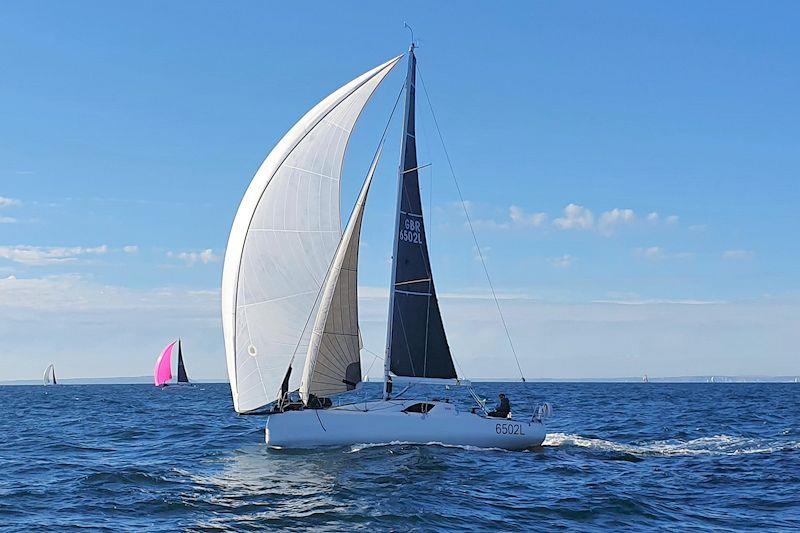
Mast hardware options for adding a staysail
by Calanach Finlayson 27 Apr 2023 09:00 PDT

Considering staysails.. © upffront.com
We have previously reported on the benefits of adding a staysail in our article, Turbo charge your ride with a staysail. We also looked at different setup options such as furling vs hanks. But what about the mast fitting?
For people looking to retrofit a staysail on a rig without an existing staysail sheave or tang, this can often be the crunch point. In this article we explore some of the possible approaches to tackling this, primarily in relation to aluminium rigs.
What kind of fitting do you need? The style of staysail you choose determines the type of mast fitting needed.
Furling GS / SS
A furling genoa staysail or spinnaker staysail is the simplest, requiring only a single halyard. A typical genoa staysail is designed to be flown together with a jib or reaching sail and not as a storm jib. This means the loads on the halyard are relatively low, and less still for a spinnaker staysail.
A dedicated staysail halyard can be provided for with any suitably sized single sheave box.
Hanked on staysail
A staysail with hanks requires not only a halyard, but also a fixed point for the stay which should be a short distance above the halyard sheave. A Dyneema stay is by far the best option for being cost effective and minimising weight aloft. Also, a Dyneema stay won't smack against the rig so aggressively as wire when brought back to the mast, if installed with the option to disconnect at the base. A Dyneema stay requires a simple rounded eye, such as the Selden O-fitting.
A wire stay can be added either with a traditional mast tang, which connects to a swaged eye via a toggle, or with a T-hanger and backing plate.
Modifying the mast
Adding any kind of sheave box, T-hanger, tang etc will inevitably involve cutting a hole in the mast and this is where you might find yourself in a bit of a quandary, debating the structural implications of doing so. We regularly see this playing out along the following lines:
- The mast manufacturer is contacted for comment but declines to approve the modification. This would require additional engineering calculations and besides, they would have zero control over the quality of work carried out by a local rigger
- It's then up to the rigger if they will accept the job without the mast manufacturer's blessing, based on their own experience
- Of course, this also depends on the approach of the owner. Some owners will take matters into their own hands (and perhaps even the angle grinder)
So much of the marine industry relies on the experience and knowledge of individuals. Part of our mission at Upffront is to collate and disseminate this knowledge to help boat owners make informed choices. But in some cases, such as this, there are simply too many variables at play to put together a robust guide. Speak to an experienced rigger and look for other boats that have made a similar modification.
As well as cutting a hole in the rig, you are also adding a new force vector when the staysail is loaded. So consider the height of the attachment and what this means for the rig tension. For example, an old school mast with inline spreaders is likely to need a checkstay to balance out a staysail, where a modern rig with 18-22 degree spreader angle is more suited to take the load.
It's just as important to evaluate the deck attachment for the new stay and the stiffness at this point. Is there enough deck structure or does it need reinforcement?
A less intrusive option
An alternative option worth considering is to use an existing halyard. Many boats have a second genoa halyard which exits the mast parallel to, or just below, the primary genoa sheave. This typically doubles as a secondary jib halyard for making racing headsail changes, as well as being the topping lift for a symmetric pole. The exit height of this halyard ('I' measurement) is ok for a spinnaker staysail which is used in combination with a kite, but too high for a genoa staysail as it does not offer sufficient separation.
But, by adding a single spectacle lower down the rig at the appropriate height for a GS, this halyard can be run down the outside of the rig to the spectacle and re-purposed. With this setup you are only adding 4 rivets to the mast and not cutting out a slot. This isn't without trade-off though. What if you also need the option of a second genoa halyard? By using a soft shackle or cowhitch on the halyard, you can remove the shackle and re-run the end out of the spectacle while racing. This does require someone going up the rig to the height of the spectacle.
To summarise...
Here is a quick checklist for retrofitting a staysail option to a mast:
- Evaluate the style of staysail you want
- This determines the fitting(s) needed
- The trickiest part to consider is the structural implication of adding a new stay
- Look for experienced advice and other examples
- Instead of adding a sheave box, consider using an existing halyard and simply fitting a spectacle lower down the rig
